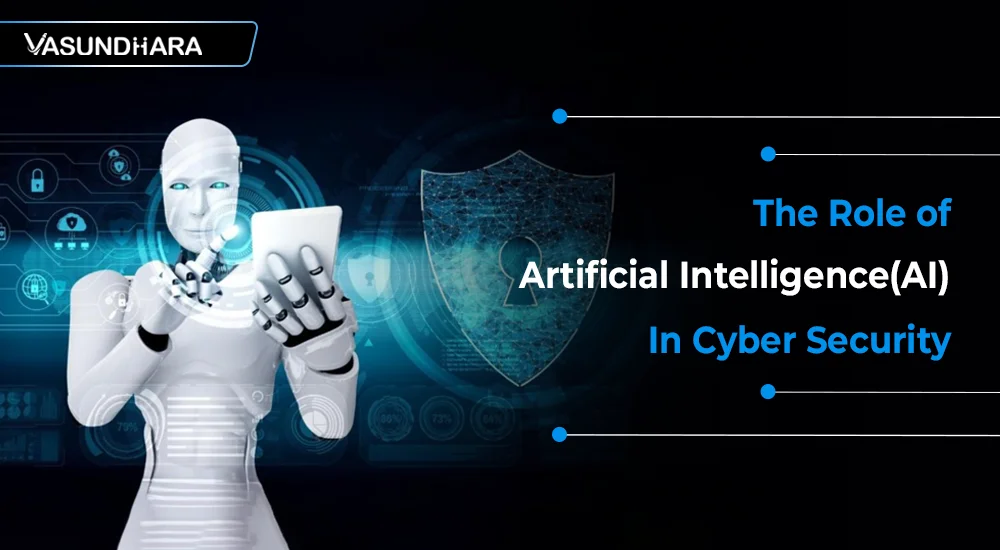The Role of Artificial Intelligence (AI) in Cyber Security


- Nov 22, 2024



In today’s rapidly evolving digital landscape, cybersecurity has become a critical concern for businesses, governments, and individuals alike. As cyber threats grow more sophisticated and pervasive, traditional security measures are proving inadequate in keeping pace with the evolving threat landscape. This is where Artificial Intelligence (AI) steps in, offering the potential to revolutionize cybersecurity by improving threat detection, enhancing response times, and automating repetitive tasks.
In this comprehensive guide, we will explore AI's transformative role in cybersecurity, its benefits and challenges, the role of AI in cybersecurity, and the ways organizations can leverage AI to protect their digital assets.
Cybersecurity is the practice of protecting systems, networks, and data from cyber-attacks. These attacks can take many forms, such as data breaches, malware, phishing, ransomware, etc. The increasing reliance on digital technologies and the rise in cybercrime has led to an unprecedented demand for robust cybersecurity solutions.
However, traditional cybersecurity approaches often need help to address the evolving complexity of cyber threats. Cybercriminals constantly find new ways to bypass security defenses, making it difficult for human teams to keep up. This is where AI can be a game-changer.
AI's ability to analyze vast amounts of data at high speeds makes it an ideal candidate for bolstering cybersecurity defenses. By combining Artificial intelligence and Cybersecurity, security teams can move beyond reactive responses and adopt proactive, data-driven approaches to identifying and mitigating threats.
Also read: What is Generative AI? Everything You Need to Know
Artificial Intelligence brings several powerful capabilities to cybersecurity, transforming the way organizations defend themselves against cyber threats.
Here are the key areas where AI is making a significant impact:
One of the most prominent roles AI plays in cybersecurity is threat detection. AI-powered tools can analyze massive volumes of data in real time, allowing them to identify patterns that may indicate suspicious or malicious activity.
AI can monitor normal behavior within a network, and when deviations occur, it can flag these anomalies as potential threats. This is especially useful in detecting insider threats, which can be difficult to spot using traditional methods.
Cybercriminals frequently develop new malware variants to evade detection. AI-powered systems can detect zero-day attacks by identifying unusual behavior, even when the malware’s signature is unknown.
AI doesn’t just stop at detecting current threats; it also excels at predicting future attacks. AI systems can identify potential vulnerabilities through predictive analytics before they are exploited.
AI-powered threat intelligence platforms can analyze global threat data, identifying patterns and trends to predict where future attacks might occur. This enables organizations to stay one step ahead of cybercriminals by strengthening their defenses proactively.
One of AI's major advantages is its ability to automate repetitive and time-consuming tasks, freeing cybersecurity professionals to focus on more strategic responsibilities.
When a security breach occurs, time is of the essence. AI can automate parts of the incident response process, such as identifying the nature of the attack, isolating affected systems, and even initiating countermeasures, reducing the time it takes to respond to threats.
AI can automate vulnerability scanning processes, ensuring that any potential weaknesses in a system are identified and patched before they can be exploited.
Also read: The Role of AI and ML in DevOps Transformation
Security analysts are often inundated with alerts and data logs, making it challenging to sift through all the information to identify real threats. AI enhances security analytics by filtering out false positives, improving accuracy, and providing actionable insights.
AI can continuously learn from new data, improving its ability to detect complex threats over time. By analyzing historical data, machine learning models can identify unusual patterns that might otherwise be missed.
The integration of AI into cybersecurity brings a wealth of benefits to organizations, helping them enhance their security posture and reduce risk. Let’s explore some of these key benefits.
AI’s ability to process large datasets in real-time allows organizations to detect and respond to threats much faster than with traditional methods.
This reduces the window of opportunity for attackers and minimizes the potential damage.
False positives can overwhelm security teams, leading to alert fatigue and missed genuine threats.
AI-powered systems can filter out false positives by using machine learning algorithms to distinguish between benign and malicious activities, improving detection accuracy.
AI significantly improves the efficiency of security operations by automating repetitive tasks such as log analysis, vulnerability scanning, and patch management.
This allows human experts to focus on more complex tasks that require critical thinking and strategy.
AI enables organizations to adopt a proactive approach to cybersecurity by predicting potential threats before they occur.
This is a game-changer in cybersecurity, as it allows businesses to address vulnerabilities before attackers can exploit them.
While AI has immense potential to transform cybersecurity, it’s essential to recognize the challenges and limitations associated with the implementation of AI cybersecurity.
Just as AI can be used to bolster cybersecurity, cybercriminals can also use AI to enhance their attacks.
Adversarial AI refers to hackers using AI techniques to create more sophisticated malware, launch automated attacks, and evade detection. This means that cybersecurity solutions must continually evolve to stay ahead of AI-driven threats.
AI systems rely heavily on data to function effectively. However, there are concerns regarding data privacy and the potential for bias in AI algorithms.
If the training data is incomplete or biased, the AI model may produce inaccurate results, potentially leading to security blind spots.
Implementing AI in cybersecurity requires significant infrastructure, expertise, and resource investments.
For smaller organizations, developing and maintaining AI-powered security systems may be prohibitive.
While AI can automate many tasks, it’s essential not to become overly reliant on AI for cybersecurity.
Human expertise is still critical in interpreting AI insights, making strategic decisions, and handling complex scenarios that AI may not be equipped to manage.
Also read: How To Build An AI Software: A Comprehensive Guide
To maximize the effectiveness of AI in cybersecurity, organizations should follow these best practices:
AI is not a replacement for human cybersecurity professionals but a tool to augment their capabilities.
Organizations should combine AI-powered tools with human oversight to ensure that AI insights are interpreted accurately and that decisions are made based on a comprehensive understanding of the threat landscape.
AI systems improve over time as they learn from new data. Organizations should continuously train AI models, ensuring that they remain up-to-date with the latest threats and can adapt to emerging attack vectors.
Since AI systems rely on large amounts of data, organizations must prioritize data security and privacy.
This includes implementing robust encryption protocols, ensuring compliance with data protection regulations, and carefully selecting the data to train AI models to avoid bias.
There are many AI-powered cybersecurity tools available on the market. Organizations should carefully evaluate their options, selecting tools aligning with their needs, threat landscape, and security goals.
AI systems are not infallible, and their performance can degrade over time if not properly monitored. Organizations should conduct regular assessments to ensure that AI models continue to perform effectively and that any vulnerabilities are addressed promptly.
Also read: Top Ways To Improve UX Design With AI
As AI technology continues to advance, its role in cybersecurity will only become more prominent. Here are some trends to watch for in the future of AI-driven cybersecurity:
In the future, AI will play an increasingly supportive role in cybersecurity teams, helping to automate low-level tasks while allowing human experts to focus on high-level strategy and complex problem-solving.
In the long term, we may see the emergence of fully autonomous AI-driven cyber defense systems capable of detecting, responding to, and mitigating threats without human intervention. While we are still far from achieving this vision, AI is gradually moving towards greater autonomy in cybersecurity.
Quantum computing is expected to revolutionize cybersecurity and AI in the coming years. With the potential to solve complex problems at unprecedented speeds, it could enhance AI’s ability to detect and prevent cyber threats.
However, it also presents new challenges, as quantum-powered attacks could outpace current defenses.
Also read: How AI is Transforming the Financial Services Industry
In conclusion, AI plays a transformative role in cybersecurity, enabling organizations to detect, prevent, and respond to threats more efficiently and effectively. As cyber threats continue to evolve, AI will be essential in ensuring the safety and integrity of digital assets.
However, it’s important to remember that AI is not a standalone solution but a powerful tool that must be used with human expertise and strategic planning. Partnering with a leading AI development company can help businesses harness the full potential of AI-driven cybersecurity solutions to stay ahead of emerging threats.
Copyright © 2025 Vasundhara Infotech. All Rights Reserved.